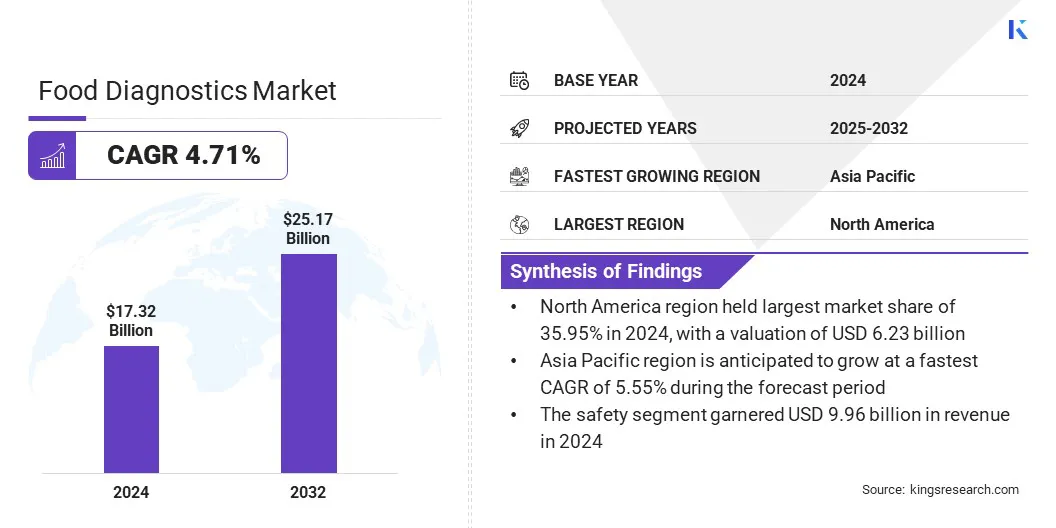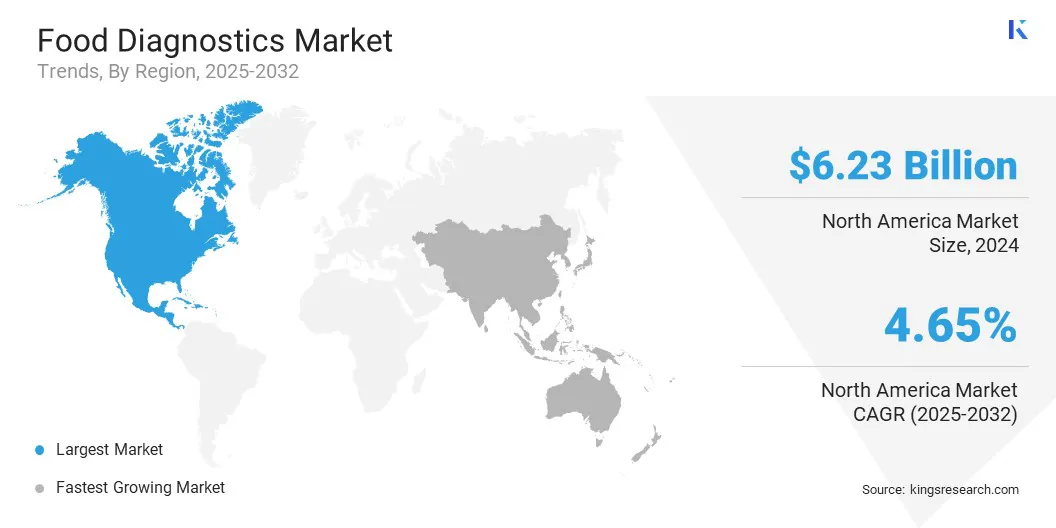buyNow
Food Diagnostics Market
Food Diagnostics Market Size, Share, Growth & Industry Analysis, By Component (Systems, Test Kits, Consumables), By Type (Safety, Quality), By Food (Dairy, Bakery), By Food, and Regional Analysis, 2025-2032
pages: 170 | baseYear: 2024 | release: July 2025 | author: Versha V.
Market Definition
Food diagnostics are analytical tools, instruments, and reagents designed to detect contaminants, pathogens, allergens, and quality indicators in food. They are essential for maintaining food safety and quality across the supply chain. They enable producers, processors, and regulatory bodies to identify biological and chemical hazards, ensure compliance with safety standards, and prevent foodborne illnesses.
The global food diagnostics market size was valued at USD 17.32 billion in 2024 and is projected to grow from USD 18.08 billion in 2025 to USD 25.17 billion by 2032, exhibiting a CAGR of 4.71% during the forecast period.
This growth is fueled by the growing demand for pathogen testing solutions amid stricter food safety regulations and rising foodborne illness cases. A key trend is the adoption of automated feeders for high-throughput food safety testing, enhancing efficiency and accuracy in large-scale diagnostic operations.
Key Highlights:
- The food diagnostics industry size was recorded at USD 17.32 billion in 2024.
- The market is projected to grow at a CAGR of 4.71% from 2025 to 2032.
- North America held a share of 35.95% in 2024, valued at USD 6.23 billion.
- The systems segment garnered USD 6.66 billion in revenue in 2024.
- The safety segment is expected to reach USD 14.08 billion by 2032.
- The dairy segment is projected to generate a revenue of USD 6.32 billion by 2032.
- Asia Pacific is anticipated to grow at a CAGR of 4.71% over the forecast period.
Major companies operating in the food diagnostics market are Shimadzu Corporation, ALS, Merck KGaA, QIAGEN, BIOMÉRIEUX, Thermo Fisher Scientific Inc., Bruker, Agilent Technologies, Inc., Eurofins Scientific, Beckman Coulter, Inc., SGS Société Générale de Surveillance SA, Bureau Veritas, Neogen Corporation, Intertek Group plc, and Bio-Rad Laboratories, Inc.

Food Diagnostics Market Report Snapshot
|
Segmentation |
Details |
|
By Component |
Systems, Test Kits, Consumables |
|
By Type |
Safety, Quality |
|
By Food |
Dairy, Bakery, Meat, Processed Foods, Cereals & Grains, Fruits & Vegetables, Others |
|
By Region |
North America: U.S., Canada, Mexico |
|
Europe: France, UK, Spain, Germany, Italy, Russia, Rest of Europe | |
|
Asia-Pacific: China, Japan, India, Australia, ASEAN, South Korea, Rest of Asia-Pacific | |
|
Middle East & Africa: Turkey, U.A.E., Saudi Arabia, South Africa, Rest of Middle East & Africa | |
|
South America: Brazil, Argentina, Rest of South America |
Food Diagnostics Market Regional Analysis
Based on region, the global market has been classified into North America, Europe, Asia Pacific, Middle East & Africa, and South America.
North America food diagnostics market share stood at 35.95% in 2024, valued at USD 6.23 billion. This dominance is reinforced by strong collaborations between the U.S. Food and Drug Administration (FDA) and private companies.
These collaborations have accelerated the development and deployment of advanced diagnostic systems across the region. They support the implementation of standardized food safety practices and enable faster responses to contamination incidents. These initiatives have positioned North America as the leading market for food diagnostics.
- In February 2024, bioMérieux and the U.S. Food and Drug Administration (FDA) initiated a strategic research collaboration through FDA’s Center for Food Safety and Applied Nutrition. The partnership focuses on developing advanced microbial detection and characterization tools to address food-borne pathogens.

The Asia-Pacific food diagnostics industry is poised to grow at a significant CAGR of 5.55% over the forecast period. This growth is propelled by rising foodborne illness cases across densely populated countries. This is leading to increased demand for pathogen testing solutions in countries such as China, India, Japan, South Korea, and Australia.
Food safety authorities in the region are enhancing surveillance measures and promoting the adoption of rapid diagnostics. Local producers are investing in modern testing tools to improve compliance and align with international food safety standards, supporting regional market expansion.
Food Diagnostics Market Overview
Market expansion is propelled by the rising demand for rapid and easy-to-use food diagnostic tests. Food manufacturers and regulatory bodies are increasingly adopting solutions that deliver quick results with minimal training or specialized equipment.
These user-friendly tests support on-site decision-making and reduce delays in production and distribution. Their growing use in small and mid-sized facilities is accelerating adoption across diverse food sectors.
- In November 2023, Gold Standard Diagnostics introduced Microgen rapid latex agglutination tests for the confirmatory identification of Salmonella, Legionella, and Staphylococcus aureus colonies in food and environmental samples. The products Microgen Legionella, Microgen Salmonella, and Microgen Staph are designed to integrate seamlessly into laboratory workflows without the need for specialized training or equipment.
Market Driver
Growing Demand for Pathogen Testing Solutions
The expansion of the food diagnostics market is fueled by the growing demand for pathogen testing solutions. Rising cases of foodborne illnesses have increased pressure on food producers to implement routine microbial testing.
Regulatory bodies across various countries now require strict compliance with safety standards, highlighting the need for fast and accurate detection of pathogens such as Salmonella, Listeria, and E. coli. Companies are adopting advanced diagnostic tools to ensure product safety, avoid recalls, and maintain consumer trust. The demand for pathogen testing continues to grow as manufacturers focus on strengthening food safety across their operations.
- In January 2025, Neogen Corporation launched the MDA2 Quantitative Salmonella Molecular Detection Assay (MDA2QSAL96) to support advanced pathogen testing in the poultry industry. The assay combines qualitative molecular detection with Quantitative Rapid Enrichment Dehydrated (QRED) media, enabling controlled bacterial growth for improved quantitation.
Market Challenge
High Cost of Advanced Diagnostic Technologies
A major challenge hampering the expansion of the food diagnostics market is the high cost of advanced diagnostic systems. Small and mid-sized food manufacturers often lack the resources to invest in high-throughput instruments and specialized test kits.
This limits the adoption of modern testing solutions, particularly in cost-sensitive markets. The challenge affects market growth by creating a gap between regulatory requirements and actual implementation.
To address this challenge, companies are offering modular systems that scale with user needs. They are also introducing subscription-based pricing and rental models to lower upfront investment and support broader adoption.
Market Trend
Adoption of Automated Feeders for High-Throughput Food Safety Testing
The food diagnostics market is experiencing a significant trend toward the adoption of automated feeders for high-throughput food safety testing. These systems improve operational efficiency by automating sample handling and preparation reducng manual errors, and ensuring consistent test results.
Laboratories use automated feeders to process large volumes of samples within shorter timeframes, meeting the rising industry demand for faster throughput, accuracy, and regulatory compliance. The trend is prominent in sectors such as meat, dairy, and processed foods, where frequent testing and short turnaround times are critical.
- In June 2024, Neogen Corporation launched the Petrifilm Automated Feeder to improve efficiency in high-throughput food safety testing laboratories. The system automates the feeding and enumeration of up to 300 Petrifilm Plates in 33 minutes, reducing hands-on time from four hours to one minute.
Market Segmentation
- By Component (Systems, Test Kits, and Consumables): The systems segment earned USD 6.66 billion in 2024, largely due to increasing demand for automated and high-throughput food testing equipment across large-scale production facilities.
- By Type (Safety and Quality): The safety segment held a share of 57.49% in 2024, fueled by strict global food safety regulations and rising incidences of foodborne illnesses.
- By Food (Dairy, Bakery, Meat, Processed Foods, Cereals & Grains, Fruits & Vegetables, and Others): The dairy segment is projected to reach USD 6.32 billion by 2032, owing to the high risk of microbial contamination and the need for routine quality and safety testing.
Regulatory Frameworks
- In the U.S., the Food and Drug Administration (FDA) regulates food diagnostics under the Food Safety Modernization Act (FSMA), which mandates preventive controls and science-based testing protocols.
- In Europe, food diagnostics must comply with EU Regulation (EC) No. 882/2004 and Regulation (EC) No. 2073/2005, which establish criteria for official controls and microbiological testing.
- In Japan, the Ministry of Health, Labour and Welfare (MHLW) enforces food safety under the Food Sanitation Act and requires validated testing methods for imported and domestic food products.
Competitive Landscape
Key players in the food diagnostics industry are prioritizing partnerships and product launches to expand their market presence. Companies are forming strategic collaborations with food producers, laboratories, and technology firms to co-develop faster and more accurate testing solutions.
These partnerships help integrate diagnostics into processing workflows and support compliance with local regulatory standards. Companies are also introducing new test kits and automated systems that reduce turnaround time and improve detection accuracy.
They continue to invest in expanding their product lines to serve a wider range of food categories and testing requirements. These strategies help strengthen market reach and support adoption across diverse regions.
- In March 2024, DKSH entered an exclusive partnership with Hygiena to distribute its food safety and health diagnostics solutions in the Philippines. The collaboration aims to expand access to Hygiena’s rapid microbial detection technologies, including ATP Cleaning Verification systems, across sectors such as food and beverage, healthcare, hospitality, pharmaceuticals, and water testing.
List of Key Companies in Food Diagnostics Market:
- Shimadzu Corporation
- ALS
- Merck KGaA
- QIAGEN
- BIOMÉRIEUX
- Thermo Fisher Scientific Inc.
- Bruker
- Agilent Technologies, Inc.
- Eurofins Scientific
- Beckman Coulter, Inc.
- SGS Société Générale de Surveillance SA
- Bureau Veritas
- Neogen Corporation
- Intertek Group plc
- Bio-Rad Laboratories, Inc.
Recent Developments (Product Launch)
- In February 2025, bioMérieux launched GENE-UP TYPER, a real-time PCR solution for the rapid identification of Listeria monocytogenes contamination sources in the food industry. The system integrates a targeted assay with the AUGMENTED-DX web application to facilitate strain characterization and cluster tracking using machine learning.
freqAskQues
